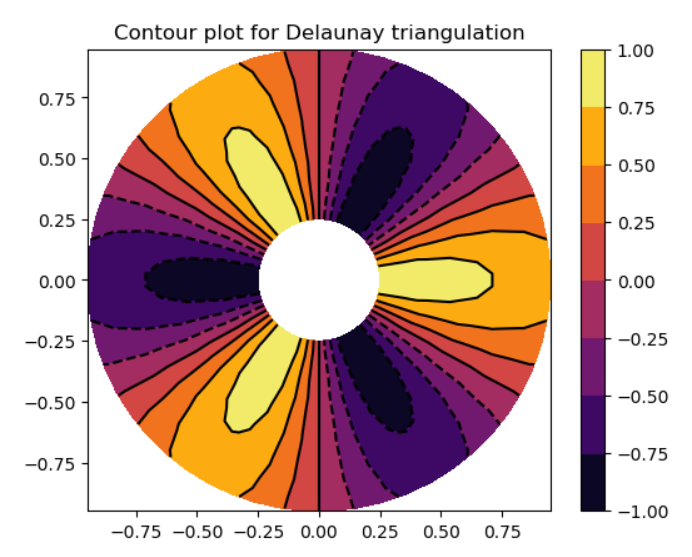使用 Matplotlib 在Python中的非结构化三角形网格上绘制轮廓
Matplotlib是一个Python库,它是一个支持丰富绘图类型的开源绘图库,可用于绘制 2D 和 3D 图形。通过在matplotlib的帮助下可视化数据,可以轻松理解数据。您还可以生成绘图、饼图、直方图和许多其他图表。它提供了一个类似 MATLAB 的绘图界面。
三等高线()
matplotlib 库 pyplot 模块的tricontour函数绘制轮廓线,可用于在非结构化三角形网格上绘制轮廓。它返回TriContourSet对象。
Syntax : tricontour(x, y, triangulation, **kwargs)
Parameters : This method consists of the following parameters.
- x, y : Coordinates of the grid.
- triangulation : It is a matplotlib.tri.Triangulation object.
- z : It is the array of values to contour, one per point in the triangulation.
- N :It contours up to N+1 automatically chosen contour levels for N intervals.
- V :It draws contour lines at the values specified in sequence V and it must be in increasing order.
例子 :
import matplotlib.pyplot as plt
import matplotlib.tri as tri
import numpy as np
n_angles = 56
n_radii = 8
min_radius = 0.25
radii = np.linspace(min_radius, 0.95, n_radii)
angles = np.linspace(0, 2 * np.pi, n_angles, endpoint = False)
angles = np.repeat(angles[..., np.newaxis], n_radii, axis = 1)
angles[:, 1::2] += np.pi / n_angles
x = (radii * np.cos(angles)).flatten()
y = (radii * np.sin(angles)).flatten()
z = (np.cos(radii) * np.cos(3 * angles)).flatten()
# Create the Triangulation; no triangles so
# Delaunay triangulation created.
triang = tri.Triangulation(x, y)
# Mask off unwanted triangles.
triang.set_mask(np.hypot(x[triang.triangles].mean(axis = 1),
y[triang.triangles].mean(axis = 1))
< min_radius)
fig1, ax1 = plt.subplots()
ax1.set_aspect('equal')
tcf = ax1.tricontourf(triang, z, cmap ='inferno')
fig1.colorbar(tcf)
ax1.tricontour(triang, z, colors ='k')
ax1.set_title('Contour plot for Delaunay triangulation')
输出 :

三角轮廓()
matplotlib 库 pyplot 模块的tricontourf函数填充顶部闭合的间隔,可用于在非结构化三角形网格上绘制轮廓。函数签名和返回值与tricontour中的相同。
Syntax : tricontourf(x, y, triangulation, **kwargs)
Parameters : This method consists of the following parameters.
- x, y : Coordinates of the grid.
- triangulation : It is a matplotlib.tri.Triangulation object.
- z : It is the array of values to contour, one per point in the triangulation.
- N :It contours up to N+1 automatically chosen contour levels for N intervals.
- V :It fills the (len(V)-1) regions between the values in V and it must be in increasing order.
例子 :
import matplotlib
matplotlib.axes.Axes.tricontourf
matplotlib.pyplot.tricontourf
matplotlib.tri.Triangulation
xy = np.asarray([
[-0.101, 0.872], [-0.080, 0.883], [-0.069, 0.888],
[-0.054, 0.890], [-0.045, 0.897], [-0.057, 0.895],
[-0.073, 0.900], [-0.087, 0.898], [-0.090, 0.904],
[-0.069, 0.907], [-0.069, 0.921], [-0.080, 0.919],
[-0.073, 0.928], [-0.052, 0.930], [-0.048, 0.942],
[-0.062, 0.949], [-0.054, 0.958], [-0.069, 0.954],
[-0.087, 0.952], [-0.087, 0.959], [-0.080, 0.966],
[-0.085, 0.973], [-0.087, 0.965], [-0.097, 0.965],
[-0.097, 0.975], [-0.092, 0.984], [-0.101, 0.980],
[-0.108, 0.980], [-0.104, 0.987], [-0.102, 0.993],
[-0.115, 1.001], [-0.099, 0.996], [-0.101, 1.007],
[-0.090, 1.010], [-0.087, 1.021], [-0.069, 1.021],
[-0.052, 1.022], [-0.052, 1.017], [-0.069, 1.010],
[-0.064, 1.005], [-0.048, 1.005], [-0.031, 1.005],
[-0.031, 0.996], [-0.040, 0.987], [-0.045, 0.980],
[-0.052, 0.975], [-0.040, 0.973], [-0.026, 0.968],
[-0.020, 0.954], [-0.006, 0.947], [ 0.003, 0.935],
[ 0.006, 0.926], [ 0.005, 0.921], [ 0.022, 0.923],
[ 0.033, 0.912], [ 0.029, 0.905], [ 0.017, 0.900],
[ 0.012, 0.895], [ 0.027, 0.893], [ 0.019, 0.886],
[ 0.001, 0.883], [-0.012, 0.884], [-0.029, 0.883],
[-0.038, 0.879], [-0.057, 0.881], [-0.062, 0.876],
[-0.078, 0.876], [-0.087, 0.872], [-0.030, 0.907],
[-0.007, 0.905], [-0.057, 0.916], [-0.025, 0.933],
[-0.077, 0.990], [-0.059, 0.993]])
x = np.degrees(xy[:, 0])
y = np.degrees(xy[:, 1])
x0 = -5
y0 = 52
z = np.exp(-0.01 * ((x - x0) ** 2 + (y - y0) ** 2))
triangles = np.asarray([
[67, 66, 1], [65, 2, 66], [ 1, 66, 2],
[64, 2, 65], [63, 3, 64], [60, 59, 57],
[ 2, 64, 3], [ 3, 63, 4], [ 0, 67, 1],
[62, 4, 63], [57, 59, 56], [59, 58, 56],
[61, 60, 69], [57, 69, 60], [ 4, 62, 68],
[ 6, 5, 9], [61, 68, 62], [69, 68, 61],
[ 9, 5, 70], [ 6, 8, 7], [ 4, 70, 5],
[ 8, 6, 9], [56, 69, 57], [69, 56, 52],
[70, 10, 9], [54, 53, 55], [56, 55, 53],
[68, 70, 4], [52, 56, 53], [11, 10, 12],
[69, 71, 68], [68, 13, 70], [10, 70, 13],
[51, 50, 52], [13, 68, 71], [52, 71, 69],
[12, 10, 13], [71, 52, 50], [71, 14, 13],
[50, 49, 71], [49, 48, 71], [14, 16, 15],
[14, 71, 48], [17, 19, 18], [17, 20, 19],
[48, 16, 14], [48, 47, 16], [47, 46, 16],
[16, 46, 45], [23, 22, 24], [21, 24, 22],
[17, 16, 45], [20, 17, 45], [21, 25, 24],
[27, 26, 28], [20, 72, 21], [25, 21, 72],
[45, 72, 20], [25, 28, 26], [44, 73, 45],
[72, 45, 73], [28, 25, 29], [29, 25, 31],
[43, 73, 44], [73, 43, 40], [72, 73, 39],
[72, 31, 25], [42, 40, 43], [31, 30, 29],
[39, 73, 40], [42, 41, 40], [72, 33, 31],
[32, 31, 33], [39, 38, 72], [33, 72, 38],
[33, 38, 34], [37, 35, 38], [34, 38, 35],
[35, 37, 36]])
fig2, ax2 = plt.subplots()
ax2.set_aspect('equal')
tcf = ax2.tricontourf(x, y, triangles, z, cmap ='copper')
fig2.colorbar(tcf)
ax2.set_title('Contour plot using user-specified triangulation')
ax2.set_xlabel('Longitude (degrees)')
ax2.set_ylabel('Latitude (degrees)')
plt.show()
输出 : 
在评论中写代码?请使用 ide.geeksforgeeks.org,生成链接并在此处分享链接。